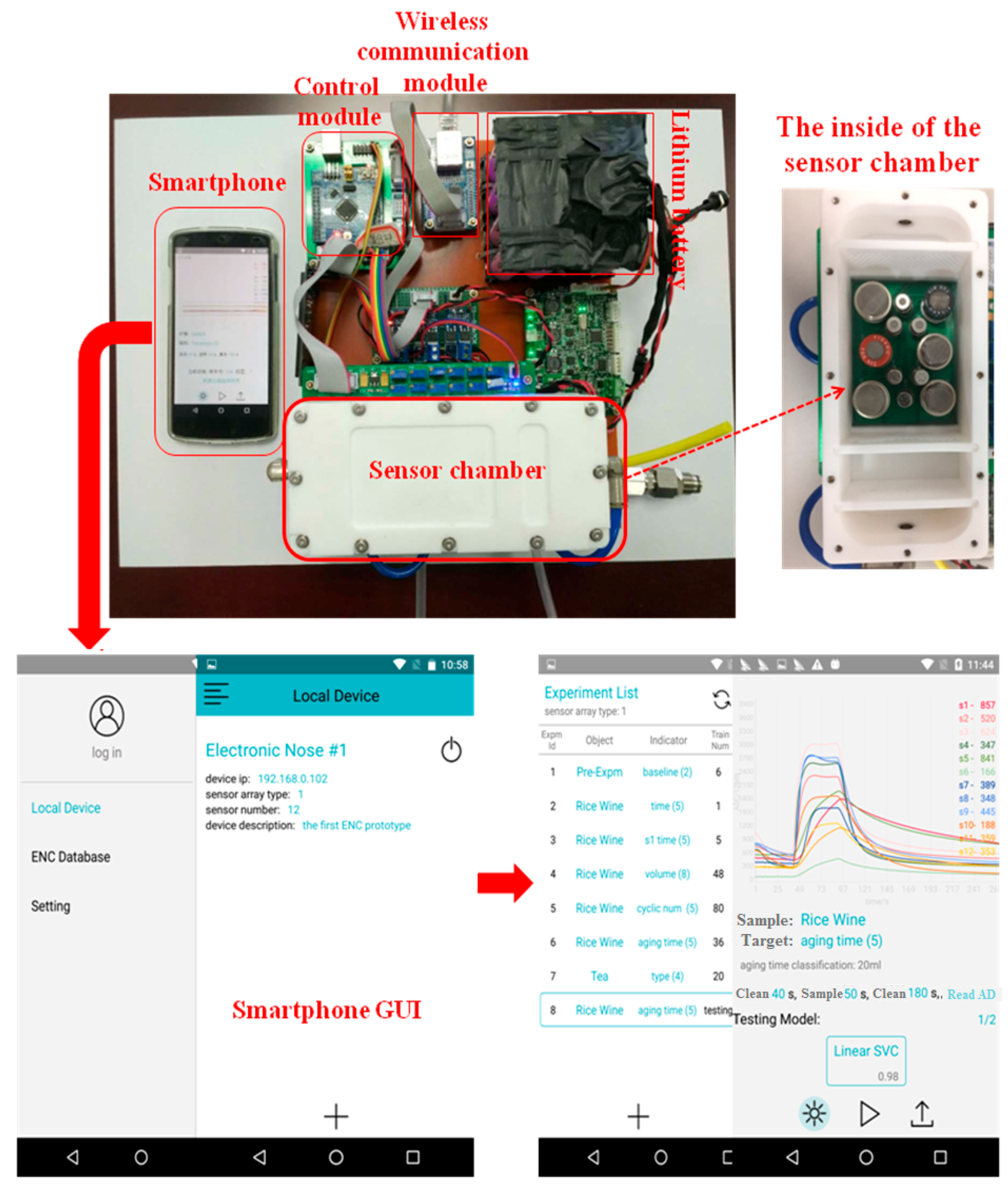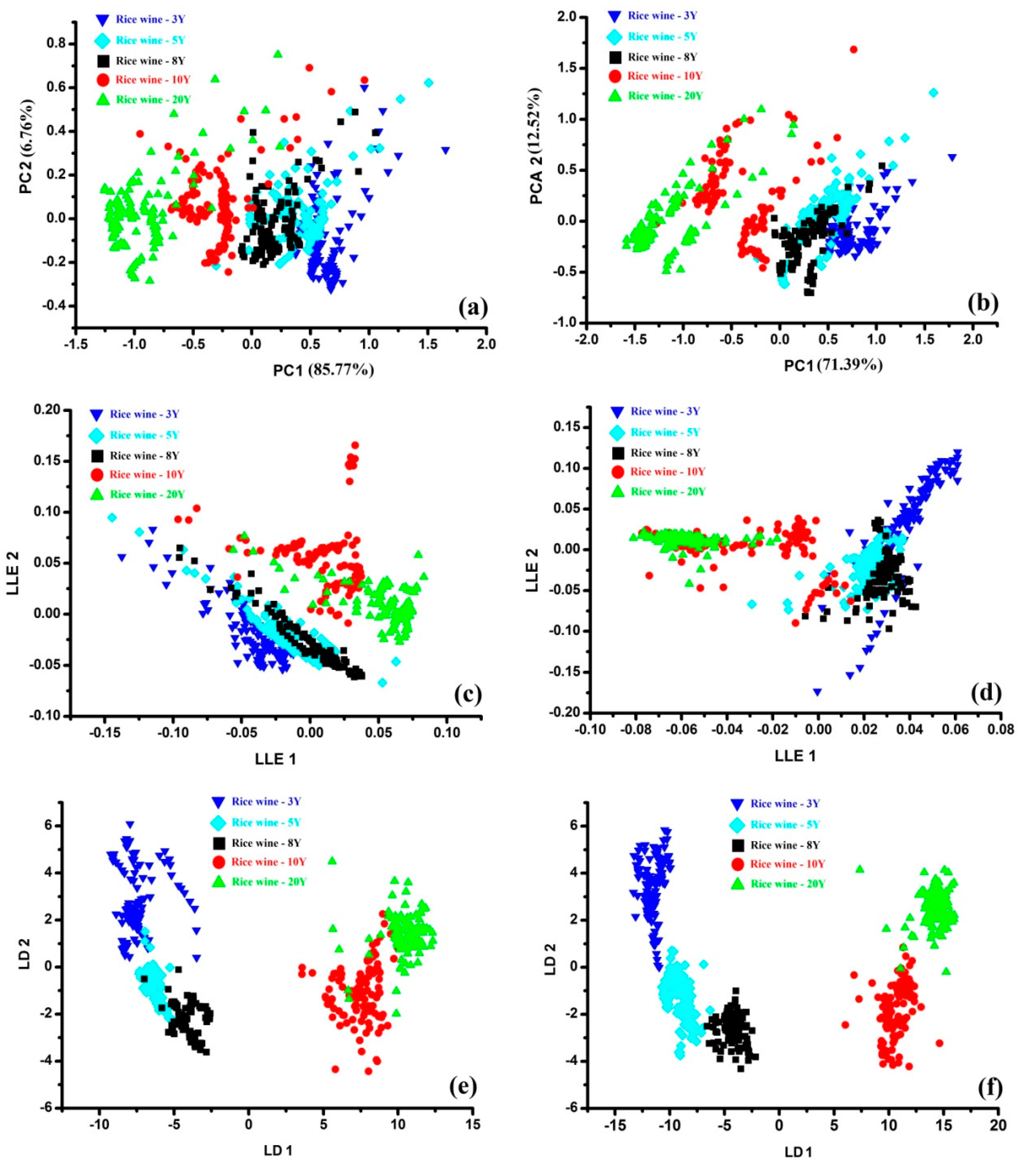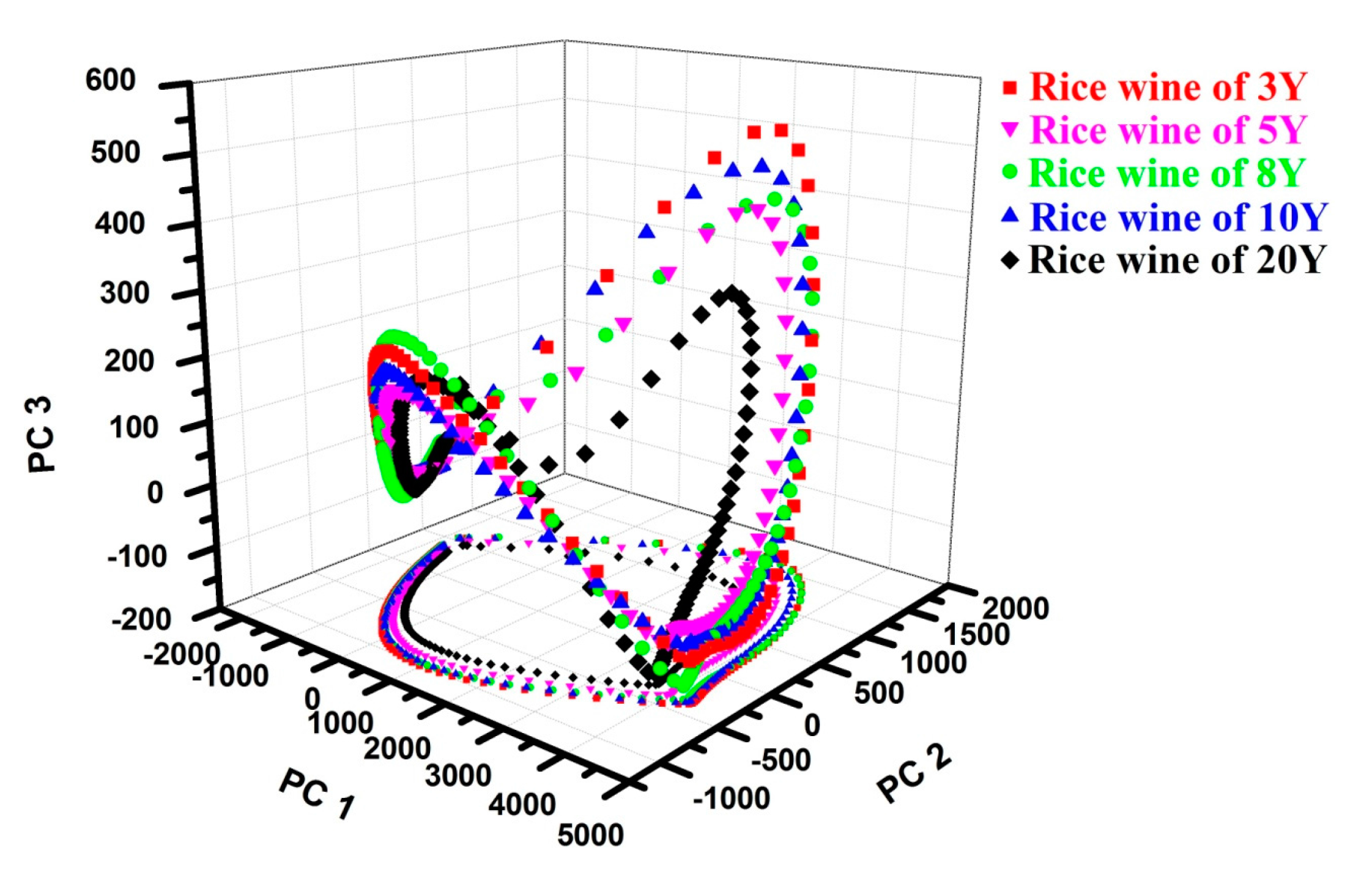Identification of the Rice Wines with Different Marked Ages by Electronic Nose Coupled with Smartphone and Cloud Storage Platform
Abstract
:1. Introduction
2. Materials and Methods
2.1. Rice Wine Samples
2.2. The Smartphone Electronic Nose Based on Cloud Platform
2.3. The Investigation of the Rice Wines with the Electronic Nose
2.4. Data Processing
3. Results and Discussion
3.1. Responses Obtained by Electronic Nose from Rice Wines
3.2. Feature Data Extraction of the Original Response
3.2.1. Area Method
3.2.2. The Compressed Data Obtained by PCA
3.3. The Classification of the Rice Wines of Different Marked Ages
3.3.1. The Classification of the Rice Wine Samples by Using PCA, LLE and LDA Based on Area Feature Data
3.3.2. The Classification of the Rice Wine Samples by Using PCA Compressed Feature Data
3.3.3. The Prediction of Marked Ages of the Rice Wine Samples
4. Conclusions
- (1)
- The communication between the Smartphone and sensor array was a wireless module and the Smartphone worked as a computer and the Aliyun storage platform worked as hard disc. All the response signals and identification models was stored in the Aliyun through the Smartphone. Compared with the traditional E-nose, the E-nose developed in this study saved lots of space. Moreover, the E-nose can be applied for on-line detection because its small size and portability.
- (2)
- The measurement of the E-nose was separated into two phases: TIOP and AIOP and the aftertaste information was obtained in the AIOP. The results of PCA, LLE and LDA demonstrated that the addition of aftertaste information has a positive effect on the classification and the LDA, based on the feature data obtained from TIOP-AIOP, provided the best identification results. SVM worked more efficiently than PLSR for prediction and it showed the higher correlation (R2 = 0.9942) and the lower root mean square error (RMSE = 0.0404).
Supplementary Materials
Supplementary File 1Acknowledgments
Author Contributions
Conflicts of Interest
References
- Shen, F.; Wu, J.; Ying, Y.B.; Li, B.B.; Jiang, T. Differentiation of Chinese rice wines from different wineries based on mineral elemental finger printing. Food Chem. 2013, 141, 4026–4030. [Google Scholar] [CrossRef]
- Cheng, H.Y.; Liu, J.H.; Xu, Z.G.; Yin, X.F. A micro-fluidic submicroliter sample introduction system for direct analysis of Chinese rice wine by inductively coupled plasmamass spectrometry using external aqueous calibration. Spectrochim. Acta B 2012, 73, 55–61. [Google Scholar] [CrossRef]
- Zhong, J.J.; Ye, X.Q.; Fang, Z.X.; Xie, G.F.; Liao, N.B.; Shu, J.; Liu, D.H. Determination of biogenic amines in semi-dry and semisweet Chinese rice wines from the Shaoxing region. Food Control 2012, 28, 151–156. [Google Scholar] [CrossRef]
- Yu, H.Y.; Xu, H.R.; Ying, Y.B.; Xie, L.J.; Zhou, Y.; Fu, X.P. Prediction Of Trace Metals In Chinese Rice Wine By Fourier Transform Near-Infrared Spectroscopy. Trans. ASABE 2014, 49, 1463–1467. [Google Scholar] [CrossRef]
- Yang, Y.J.; Xia, Y.J.; Wang, G.Q. Effect of mixed yeast starter on volatile flavor compounds in Chinese rice wine during different brewing stages. LWT Food Sci. Technol. 2017, 78, 373–381. [Google Scholar] [CrossRef]
- Cai, Y.P.; Sun, Z.W.; Chen, G. Rapid analysis of biogenic amines from rice wine with isotope-coded derivatization followed by high performance liquid chromatography-tandem mass spectrometry. Food Chem. 2016, 192, 388–394. [Google Scholar] [CrossRef]
- Magna, G.; Zor, S.D.; Catini, A. Surface arrangement dependent selectivity of porphyrins gas sensors. Sens. Actuators B Chem. 2017, 251, 524–532. [Google Scholar] [CrossRef]
- Climent, E.; Pelegri-Sebastia, J.; Sogorb, T. Development of the MOOSY4 eNose IoT for Sulphur-Based VOCWater Pollution Detection. Sensors 2017, 17, 1917. [Google Scholar] [CrossRef]
- Wojnowski, W.; Majchrzak, T.; Dymerski, T.; Gebicki, J.; Namiesnik, J. Electronic noses: Powerful tools in meat quality assessment. Meat Sci. 2017, 131, 119–131. [Google Scholar] [CrossRef]
- Son, M.; Kim, D.; Ko, H.J. A portable and multiplexed bioelectronic sensor using human olfactory and taste receptors. Biosens. Bioelectron. 2017, 87, 901–907. [Google Scholar] [CrossRef]
- Sanaeifara, A.; ZakiDizajib, H.; Jafaria, A.; de la Guardiac, M. Early detection of contamination and defect in foodstuffs by electronic nose: A review. TrAC Trends Anal. Chem. 2017, 97, 257–271. [Google Scholar] [CrossRef]
- Giungato, P.; Laiola, E.; Nicolardi, V. Evaluation of Industrial Roasting Degree of Coffee Beans by Using an Electronic Nose and a Stepwise Backward Selection of Predictors. Food Anal. Methods 2017, 10, 3424–3433. [Google Scholar] [CrossRef]
- Paknahad, M.; Ahmadi, A.; Rousseau, J. On-Chip Electronic Nose for Wine Tasting: A Digital Microfluidic Approach. IEEE Sens. J. 2017, 17, 4322–4329. [Google Scholar] [CrossRef]
- Chung, S.; Park, T.S.; Park, S.H. Colorimetric Sensor Array for White Wine Tasting. Sensors 2015, 15, 18197–18208. [Google Scholar] [CrossRef]
- Qiu, S.S.; Wang, J. The prediction of food additives in the fruit juice based on electronic nose with chemometrics. Food Chem. 2017, 230, 208–214. [Google Scholar] [CrossRef]
- Adak, M.F.; Yumusak, N. Classification of E-Nose Aroma Data of Four Fruit Types by ABC-Based Neural Network. Sensors 2016, 16, 304. [Google Scholar] [CrossRef]
- Sharma, P.; Ghosh, A.; Tudu, B. Monitoring the fermentation process of black tea using QCM sensor based electronic nose. Sens. Actuators B Chem. 2015, 219, 146–157. [Google Scholar] [CrossRef]
- Berna, A. Metal Oxide Sensors for Electronic Noses and Their Application to Food Analysis. Sensors 2010, 10, 3882–3910. [Google Scholar] [CrossRef]
- Kriengkri, T.; Yaowapa, L.; Chatchawal, W. Identification of adulteration in uncooked Jasmine rice by a portable low-cost artificial olfactory system. Measurement 2017, 108, 67–76. [Google Scholar]
- Wang, J.; Wei, Z.B. The classification and prediction of green teas by electrochemical response data extraction and fusion approaches based on the combination of enose and e-tongue. RSC Adv. 2015, 5, 106959–106970. [Google Scholar] [CrossRef]
- Huang, L.X.; Meng, L.W.; Zhu, N. A primary study on forecasting the days before decay of peach fruit using near-infrared spectroscopy and electronic nose techniques. Postharvest Biol. Technol. 2017, 133, 104–112. [Google Scholar] [CrossRef]
- Xu, S.; Lu, E.L.; Lu, H.Z. Quality Detection of Litchi Stored in Different Environments Using an Electronic Nose. Sensors 2016, 16, 852. [Google Scholar] [CrossRef]
- Ko, E.J.; Kim, E.Y. A Vision-Based Wayfinding System for Visually Impaired People Using Situation Awareness and Activity-Based Instructions. Sensors 2017, 17, 1882. [Google Scholar]
- Ensworth, J.F.; Reynolds, M.S. BLE-Backscatter: Ultralow-Power IoT Nodes Compatible with Bluetooth 4.0 Low Energy (BLE) Smartphones and Tablets. IEEE Trans. Microw. Theory Tech. 2017, 65, 3360–3368. [Google Scholar] [CrossRef]
- Cheng, C.C.; Lee, D.S. Enabling Smart Air Conditioning by Sensor Development: A Review. Sensors 2016, 16, 2028. [Google Scholar] [CrossRef]
- Pepa, L.; Verdini, F.; Spalazzi, L. Gait Parameter And Event Estimation Using Smartphones. Gait Posture 2017, 57, 217–223. [Google Scholar] [CrossRef]
- Kim, H.S.; Jung, Y.K.; Doh, I.J. Smartphone-based low light detection for bioluminescence application. Sci. Res. 2017, 7, 40203. [Google Scholar] [CrossRef]
- Russell, S.M.; Domenech-Sanchez, A.; de la Rica, R. Augmented Reality for Real-Time Detection and Interpretation of Colorimetric Signals Generated by Paper-Based Biosensors. ACS Sens. 2017, 2, 848–853. [Google Scholar] [CrossRef]
- Yoon, J.H.; Kim, T.W.; Mendez, P. Mobile Genome Express (MGE): A comprehensive automatic genetic analyses pipeline with a mobile device. PLoS ONE 2017, 12, e0174696. [Google Scholar] [CrossRef]
- Wu, Y.X.; Liang, P.; Dong, Q.M. Design of a silver nanoparticle for sensitive surface enhanced Raman spectroscopy detection of carmine dye. Food Chem. 2017, 237, 974–980. [Google Scholar] [CrossRef]
- Souza, S.; Erica, A.; Saboia, G.; Jorge, N.C. Development of a HS-SPME-GC/MS protocol assisted by chemometric tools to study herbivore-induced volatiles in Myrcia splendens. Talanta 2017, 175, 9–20. [Google Scholar] [CrossRef]
- Zong, L.L.; Zhang, X.C.; Zhao, L. Multi-view clustering via multi-manifold regularized non-negative matrix factorization. Neural Netw. 2017, 88, 74–89. [Google Scholar] [CrossRef]
- Farrugia, R.A.; Guillemot, C. Face Hallucination Using Linear Models of Coupled Sparse Support. IEEE Trans. Image Process. 2017, 26, 4562–4577. [Google Scholar] [CrossRef]
- Wei, X.C.; Wang, Y.X.; Zhao, Y.X. Colorimetric sensor array for protein discrimination based on different DNA chain length-dependent gold nanoparticles aggregation. Biosens. Bioelectron. 2017, 97, 332–337. [Google Scholar] [CrossRef]
- Gil, L.; Barat, J.M.; Escriche, I.; Garcia-Breijo, E.; Martínez-Máñez, R.; Soto, J. An electronic tongue for fish freshness analysis using a thick-film array of electrodes. Microchim. Acta 2008, 163, 121–129. [Google Scholar] [CrossRef]
- Gao, F.; You, J.L.; Wang, J. A novel target detection method for SAR images based on shadow proposal and saliency analysis. Neurocomputing 2017, 267, 220–231. [Google Scholar] [CrossRef]
- Hartley, P.; Flamary, R.; Jackson, N. Support vector machine classification of strong gravitational lenses. Mon. Not. R. Astron. Soc. 2017, 471, 3378–3397. [Google Scholar] [CrossRef]








| Sensors Labels | Sensor Name | Target Gases | Typical Detection Range |
|---|---|---|---|
| S1 | TGS826 | Ammonia | 30–300 ppm |
| S2 | TGS822 | Alcohol, Solvent vapors | 50–5000 ppm |
| S3 | TGS816 | Methane, Butane, Propane | 500–10,000 ppm |
| S4 | TGS813 | Methane, Butane, Propane | 500–10,000 ppm |
| S5 | MQ138 | Aldehydes, alcohols, ketones, aromatics | 1 to 100 ppm |
| S6 | MQ137 | Ammonia | 5–500 ppm |
| S7 | TGS2620 | Alcohol, Solvent vapors | 50–5000 ppm |
| S8 | TGS2611 | Methane | 1–25% |
| S9 | TGS2610 | Butane, Propane | 1–25% |
| S10 | TGS2603 | Trimethylamine, methyl mercaptan | 1–10 ppm |
| S11 | TGS2602 | VOCs, ammonia, hydrogen sulfide | 1–30 ppm |
| S12 | TGS2600 | hydrogen, ethanol | 1–30 ppm |
© 2017 by the authors. Licensee MDPI, Basel, Switzerland. This article is an open access article distributed under the terms and conditions of the Creative Commons Attribution (CC BY) license (http://creativecommons.org/licenses/by/4.0/).
Share and Cite
Wei, Z.; Xiao, X.; Wang, J.; Wang, H. Identification of the Rice Wines with Different Marked Ages by Electronic Nose Coupled with Smartphone and Cloud Storage Platform. Sensors 2017, 17, 2500. https://doi.org/10.3390/s17112500
Wei Z, Xiao X, Wang J, Wang H. Identification of the Rice Wines with Different Marked Ages by Electronic Nose Coupled with Smartphone and Cloud Storage Platform. Sensors. 2017; 17(11):2500. https://doi.org/10.3390/s17112500
Chicago/Turabian StyleWei, Zhebo, Xize Xiao, Jun Wang, and Hui Wang. 2017. "Identification of the Rice Wines with Different Marked Ages by Electronic Nose Coupled with Smartphone and Cloud Storage Platform" Sensors 17, no. 11: 2500. https://doi.org/10.3390/s17112500





